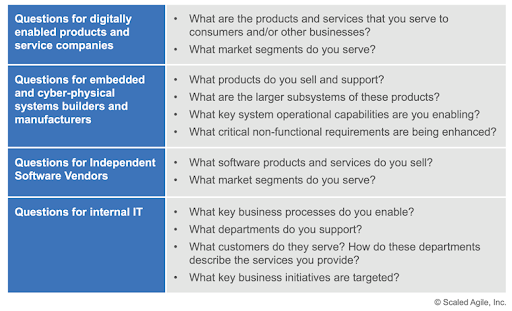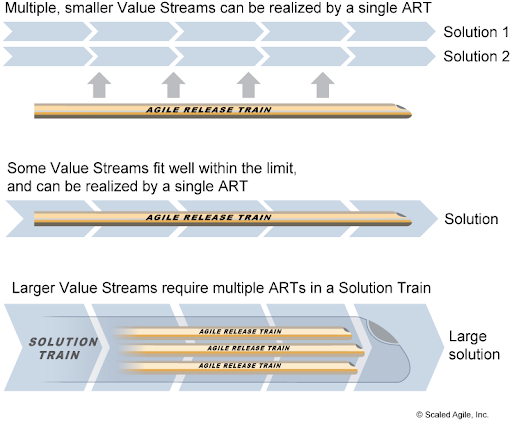In this blog series, we are taking a quick look at each of the 12 steps in the SAFe Implementation Roadmap. Previously, we discussed Training Lean-Agile Change Agents. Today we will discuss identifying Value Streams and ARTs.
There are two types of Value Streams, operational and development. Operational Value Streams contain the steps and people who deliver the customer value using the business solutions created by the development value streams. The development value streams contain the steps and people who develop the business solutions that operational value streams use. Development value streams are the value streams that SAFe improves.
There is no quick and easy way to identify value streams. Please take your time with this step.
Identify Operational Value Streams
In a small organization, this might be very easy. Typically operational value streams are just the products or services that a company sells. This could be more time-consuming in a larger organization, though, as work, flows through different departments, systems, or tools to finally deliver value. The SAFe website provides a nice image for identifying operational value streams, as shown below.
Operational Value streams typically fall into one of four categories:
- Fulfillment Value streams are where the organization is delivering a product or service in exchange for compensation.
- Manufacturing Value streams are where the organization is taking materials, building something, and delivering it to the customer.
- Software product value streams involve offering and supporting software products.
- Supporting Value streams entail end-to-end workflows for supporting various activities such as employee onboarding and offboarding.
As we can gather from the above groups, we do not typically see departments or sections of the organization as value streams. Multiple departments and sections of an organization are often involved in one value stream together.
Once we have identified all of our operational value streams, we need to define what solutions are used to support each value stream or the solutions each value stream provides to the customers. We will also need to look for what people or teams are involved in each operational value stream. These are the people who are either building or supporting the solutions. It’s also essential to identify the location of these people, whether it’s geographically or virtually.
Identify the Development Value Streams
The next step in this process is to identify the steps needed to develop the solutions mentioned above and the people involved in them. Since these are different from operational value streams, it’s important to really consider the trigger and value. If the organization thinks they can add value by developing a new feature, then the trigger would be the idea or request for that feature.
In many organizations, there will only be one value stream. This is especially true for organizations that only have one product or service. The work needed to add value to these products or services will come from a single value stream. There will be multiple value streams that are mostly or entirely independent of each other in other organizations.
After identifying the development value streams and their triggers, we should look for the people and groups involved in these streams. The entire business is likely involved in this process in some way. Think about a software company developing a new feature for their product. Not only is there the engineering team building the feature, but there is also the support team working with customers afterward. The finance team must process the payments. The legal team needs to ensure the products and services comply with regulations. The security team needs to make sure data is integrated safely and so on.
Form Agile Release Trains (ARTs)
After identifying our development value streams, we need to begin to understand the Agile Release Trains and how to form them. ARTs contain all the people and items necessary to enhance the flow of value. The first step in this journey is to find where the team is adding value. Where are these people in the business and geographically? Organizations are initially set up in different ways for a multitude of reasons. Thus, it is likely that nobody in the organization wholly understands who is doing all the work that adds value. Research has shown that ARTs have the following characteristics according to the SAFe website:
- 50 -125 people
- Focused on a holistic solution or related set of products or services
- Long-lived, stable teams that consistently deliver value
- Minimize dependencies with other ARTs
- Can release independent or other ARTs
As we start to define the ARTs, they will typically fall into three categories depending on size.
It is also possible that the organization needs to split a larger value stream into multiple ARTs. When this happens, we call it a Solution Train. To benefit the most from the value stream, the ARTs within the solution train should be designed to maximize the value flow across the entire Solution Train.
SAFe recognizes four fundamental team structures to help design ARTs.
- Stream aligned team - organized around the flow of work and can deliver value directly to the customer.
- Complicated subsystem team - organized around specific subsystems that require deep specialist skills and expertise.
- Platform team - organized around the development and support platforms that provide services to other teams.
- Enabling team - organized to assist other teams with specialized capabilities and help them become proficient in new technologies
We typically use a combination of multiple team structures to make a Solution Train.
All in all, defining value streams and Agile Release Trains is one of the most critical steps on your SAFe implementation journey. There are several workshops and tools at your disposal to help guide you on the SAFe website. The difficulty of these workshops can vary depending on your level of expertise.
Be sure to come back next week where, in part 4 of this series, we talk about creating the Implementation Plan!
Don't miss out on the previous parts of the SAFe Implementation Roadmap series!
Part 1: Getting started and reaching the tipping point
Part 2: Train lean-agile change agents
Learn more about SAFe and Agile Hive: SAFe in Jira
If you are curious about learning more about SAFe or the software-supported implementation of SAFe, ask us about Agile Hive! We would be happy to discuss your requirements for enterprise-wide agile product development and product management with you. Take a look at our Implementation Project documentation to see an overview of what an implementation would entail.
Get in touch with us today, and let us demonstrate how it works in a personal session.
Further Reading
- Agile Hive Implementation Project
- Scaled Agile: SAFe 5.0 changes and how Agile Hive maps them
- SAFe with Atlassian tools: Agile Hive is a Scaled Agile Platform Partner
- SAFe resources to get you started right
- Agile Hive: What is SAFe®?
Learn more about Creative Commons licensing and //Seibert/Media






